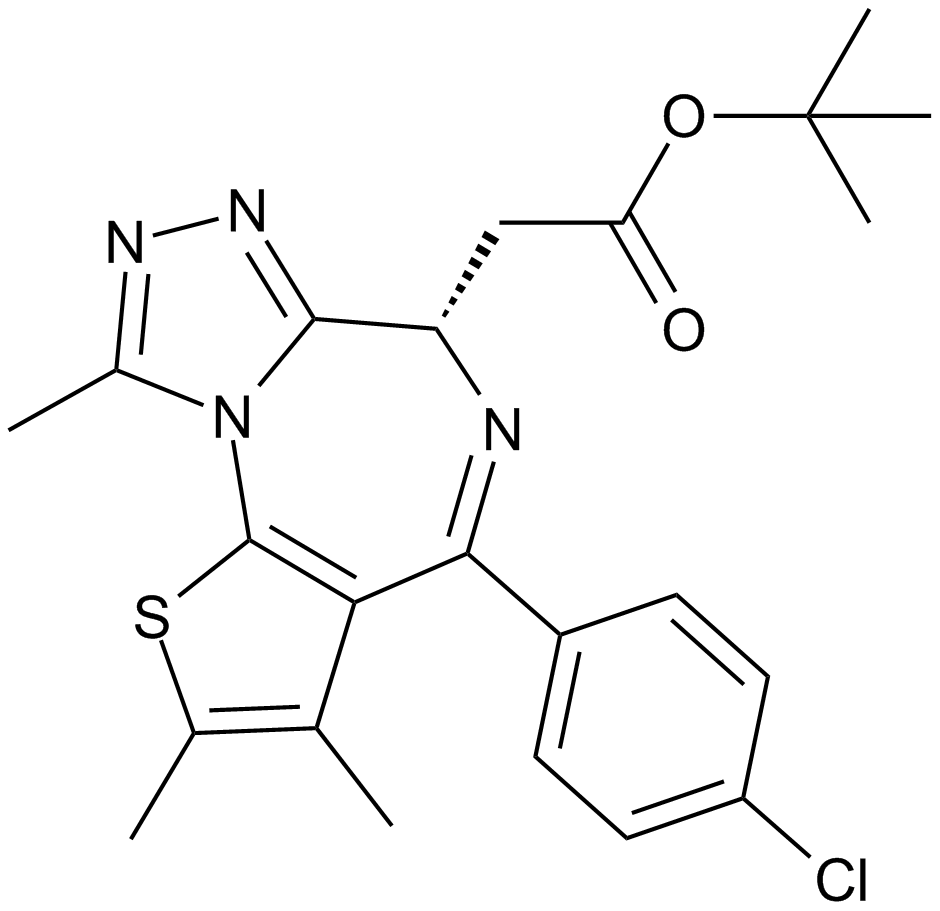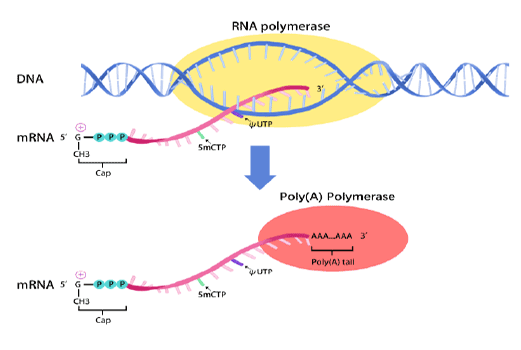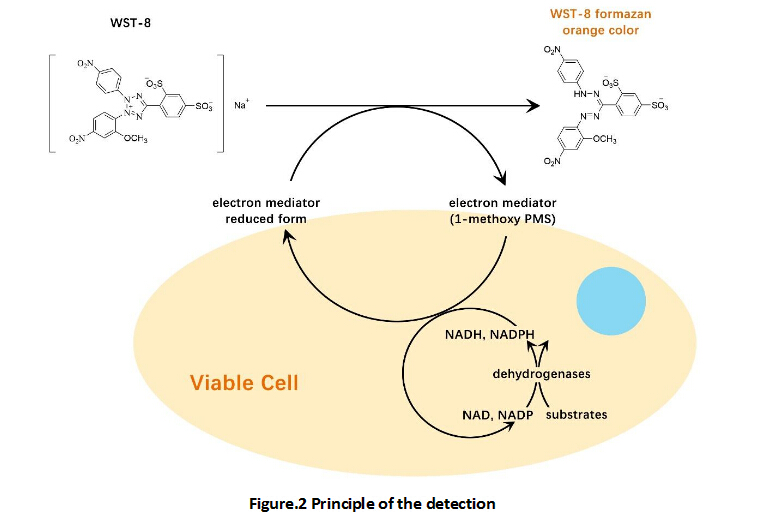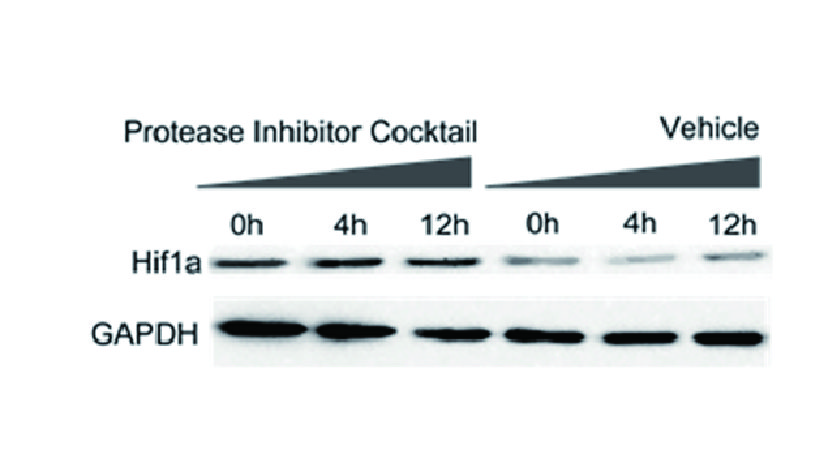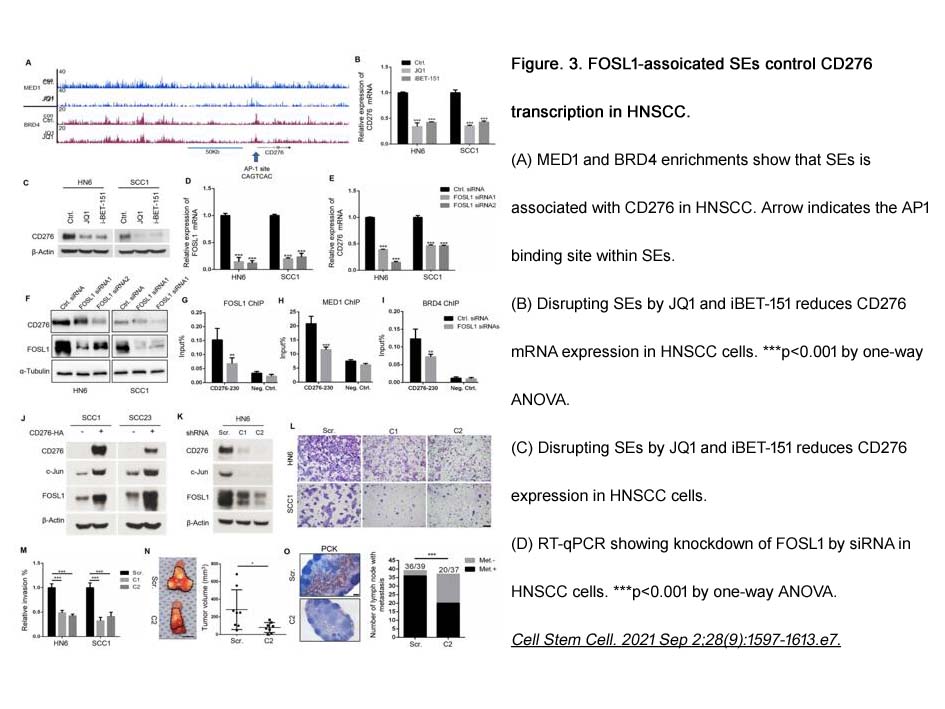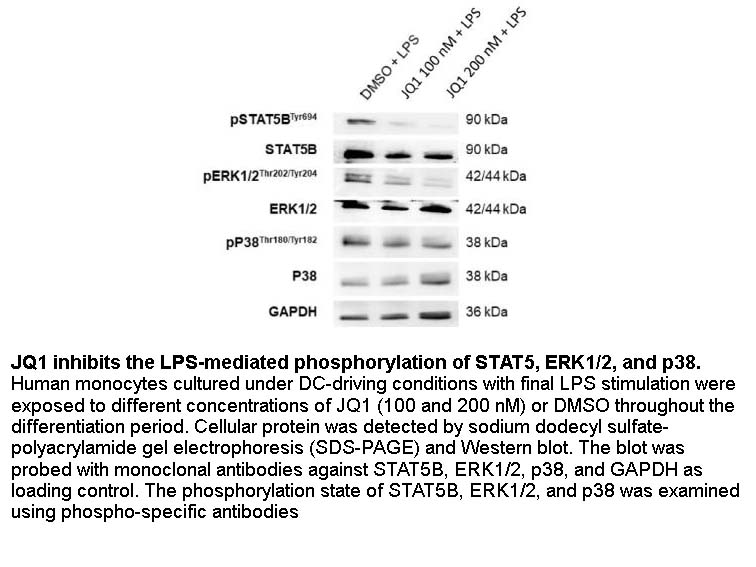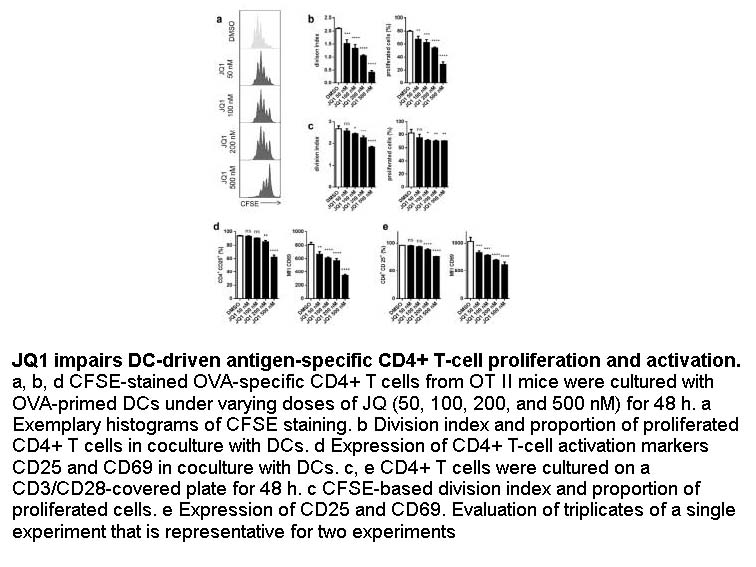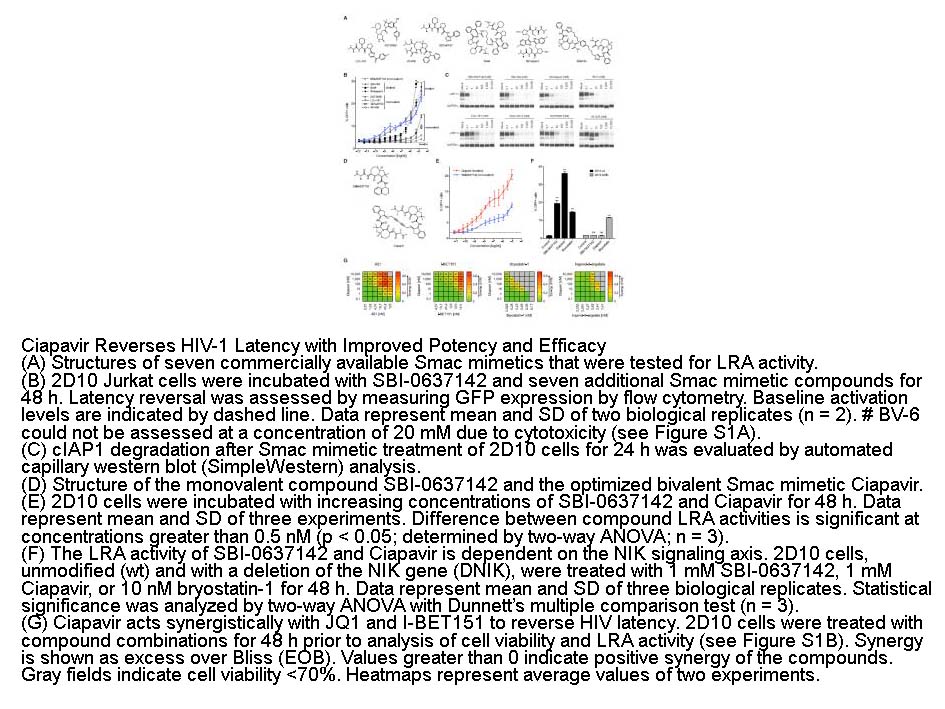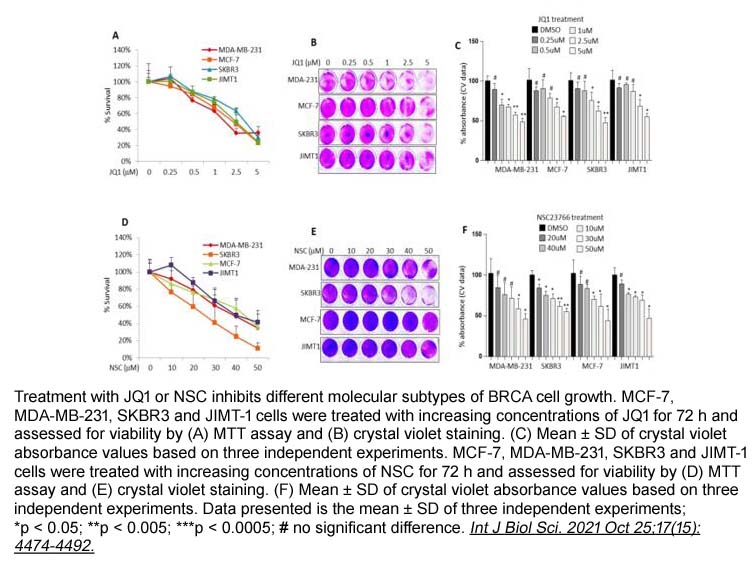Bromodomain Inhibitor, (+)-JQ1 [1268524-70-4]
Cat# A1910-1mg
Size : 1mg
Marca : APExBIO Technology
Bromodomain Inhibitor, (+)-JQ1
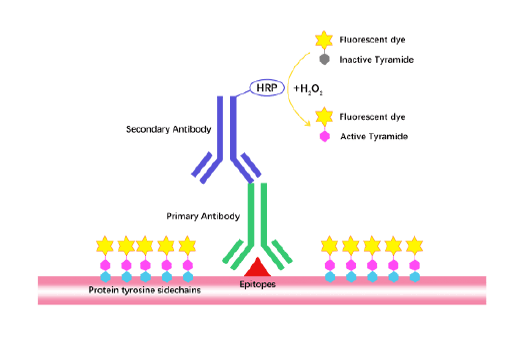
Tyramide Signal Amplification (TSA)
TSA (Tyramide Signal Amplification), used for signal amplification of ISH, IHC and IC etc.
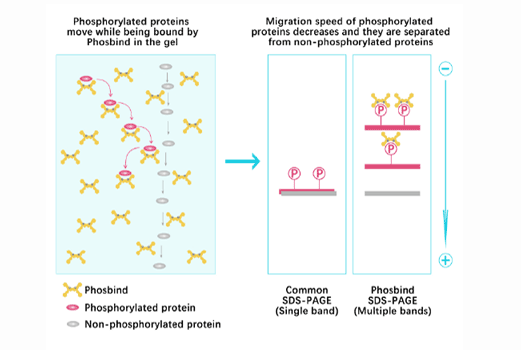
Phos Binding Reagent Acrylamide
Separation of phosphorylated and non-phosphorylated proteins without phospho-specific antibody
Bromodomain Inhibitor, (+)-JQ1 is a potent and highly specific inhibitor for the BET (bromodomain and extra-terminal) family of bromodomains. (+)-JQ1 binds to BRD4 bromodomains 1 and 2 with Kd values of ~ 50 and 90 nM, respectively. The binding is competitive with acetyl lysine. (+)-JQ1 can be a useful chemical probe to investigate the role of BET bromodomains in the transcriptional regulation of oncogenesis.
JQ1 exhibited strong dose-and time- dependent inhibition of BRDT and could significantly diminish the activity of a close structural relative of BRDT. A close look at JQ1 bound BRDT confirmed that the acetyl-lysine recognition site of BRDT was blocked. [1]
JQ1 does not produce sedative or anxiolytic effects and is instead a potent and selective inhibitor of the bromodomain testis-specific protein BRDT [2], which is essential for chromatin remodeling during spermatogenesis. By blocking BRDT, JQ1 effectively blocks the production of sperm in the testes and consequently produces effective contraception, without the negative side effects associated with previously researched hormonal contraceptives for men.
References:
1. Matzuk, Martin M., et al. "Small-molecule inhibition of BRDT for male contraception." Cell 150.4 (2012): 673-684. 2. Filippakopoulos, P.; Qi, J.; Picaud, S.; Shen, Y.; Smith, W. B.; Fedorov, O.; Morse, E. M.; Keates, T. et al. (2010). "Selective inhibition of BET bromodomains". Nature 468 (7327): 1067–1073.
- 1. Aakarsha Rao, Milan S Stosic, et al. "Targeted inhibition of BET proteins in HPV16-positive head and neck squamous cell carcinoma reveals heterogeneous transcriptional responses." Front Oncol. 2024 Sep 5:14:1440836. PMID: 39301555
- 2. Kun Dong ,Raghib Nihal, et al. "CD47 and IFT57 Are Colinear Genes That Are Highly Coexpressed in Most Cancers and Exhibit Parallel Cancer-Specific Correlations with Survival." Int. J. Mol. Sci. 2024, 25(16), 8956 PMID: 39201643
- 3. Wen Mi, Jianwei You, et al. "BET inhibition induces GDH1-dependent glutamine metabolic remodeling and vulnerability in liver cancer." Life Metabolism, Volume 3, Issue 4, August 2024.
- 4. Sicong Zhang, Robert G. Roeder, et al. "Resistance of estrogen receptor function to BET bromodomain inhibition is mediated by transcriptional coactivator cooperativity." bioRxiv. July 26, 2024.
- 5. Yi Sui, Teng Wang, et al. "Targeting Super-Enhancer-Driven Transcriptional Dependencies Suppresses Aberrant Hedgehog Pathway Activation and Overcomes Smoothened Inhibitor." Cancer Res. 2024 May 22. PMID: 38775809
- 6. Chenyang Fan, Xiaohong Guo, et al. "BRD4 inhibitors broadly promote erastin-induced ferroptosis in different cell lines by targeting ROS and FSP1." Discov Oncol. 2024 Apr 3;15(1):98. PMID: 38565708
- 7. Aakarsha Rao, Zijian Ni, et al. "Targeted inhibition of BET proteins in HPV-16 associated head and neck squamous cell carcinoma reveals heterogeneous transcription response." bioRxiv. 2023 Oct 4:2023.10.02.560587. PMID: 37873389
- 8. Wenhui Yu, Zhongyu Xie, et al. "Super enhancers targeting ZBTB16 in osteogenesis protect against osteoporosis." Bone Res. 2023 Jun 7;11(1):30. PMID: 37280207
- 9. Vanessa Ortiz-Barahona, Marta Soler, et al. "Epigenetic inactivation of the 5-methylcytosine RNA methyltransferase NSUN7 is associated with clinical outcome and therapeutic vulnerability in liver cancer." Mol Cancer. 2023 May 12;22(1):83. PMID: 37173708
- 10. Peeters JGC, Boltjes A, et al. "Epigenetic changes in inflammatory arthritis monocytes contribute to disease and can be targeted by JAK inhibition." Rheumatology (Oxford) 2023 Jan 10 PMID: 36625523
- 11. Anh Phuong Nguyen, Kaoru Yamagata, et al. "Enhancer RNA commits osteogenesis via microRNA-3129 expression in human bone marrow-derived mesenchymal stem cells." Inflamm Regen. 2022 Sep 16;42(1):43. PMID: 36114571
- 12. Agnieszka Grabowska, Hanna Sas-Nowosielska, et al. "Activation-induced chromatin reorganization in neurons depends on HDAC1 activity." Cell Rep. 2022 Feb 15;38(7):110352. PMID: 35172152
- 13. Amjad Ali, Jasmin Shafarin, et al. "Co-targeting BET bromodomain BRD4 and RAC1 suppresses growth, stemness and tumorigenesis by disrupting the c-MYC-G9a-FTH1axis and downregulating HDAC1 in molecular subtypes of breast cancer." Int J Biol Sci. 2021 Oct 25;17(15):4474-4492. PMID: 34803511
- 14. Victor Cy Mak, Xinran Li, et al. "p85β alters response to EGFR inhibitor in ovarian cancer through p38 MAPK-mediated regulation of DNA repair." Neoplasia. 2021 Jul;23(7):718-730. PMID: 34144267
- 15. Seung-Kyoon Kim, Xihui Liu, et al. "Functional coordination of BET family proteins underlies altered transcription associated with memory impairment in fragile X syndrome." Sci Adv. 2021 May 19;7(21):eabf7346. PMID: 34138732
- 16. Olga Gusyatiner, Pierre Bady, et al. "BET inhibitors repress expression of Interferon-stimulated genes and synergize with HDAC inhibitors in glioblastoma." Neuro Oncol. 2021 Oct 1;23(10):1680-1692. PMID: 33987681
- 17. Cheng Wang, Yang Li, et al. "CD276 expression enables squamous cell carcinoma stem cells to evade immune surveillance." Cell Stem Cell. 2021 Sep 2;28(9):1597-1613.e7. PMID: 33945793
- 18. Lars Pache, Matthew D. Marsden, et al. "Pharmacological Activation of Non-canonical NF-κB Signaling Activates Latent HIV-1 Reservoirs In Vivo." Cell Rep Med. 2020 Jun 23;1(3):100037. PMID: 33205060
- 19. Niklas Remke, Savita Bisht, et al. "Selective BET-bromodomain inhibition by JQ1 suppresses dendritic cell maturation and antigen-specific T-cell responses." Cancer Immunol Immunother. 2020 Jul 10. PMID: 32651619
- 20. Xiang Y, Tanaka Y, et al. "Dysregulation of BRD4 Function Underlies the Functional Abnormalities of MeCP2 Mutant Neurons." Mol Cell. 2020;79(1):84-98.e9. PMID: 32526163
- 21. Wu SY, Lee CF, et al. "Opposing Functions of BRD4 Isoforms in Breast Cancer." Mol Cell. 2020;78(6):1114-1132.e10. PMID: 32446320
- 22. Xu Y, Wu Y, et al. "A Tumor-Specific Super-Enhancer Drives Immune Evasion by Guiding Synchronous Expression of PD-L1 and PD-L2." Cell Rep. 2019 Dec 10;29(11):3435-3447.e4. PMID: 31825827
- 23. Huang Y, Mouttet B, et al. "The Leukemogenic TCF3-HLF Complex Rewires Enhancers Driving Cellular Identity and Self-Renewal Conferring EP300 Vulnerability." Cancer Cell. 2019 Nov 1. pii: S1535-6108(19)30478-7. PMID: 31735627
- 24. Zhu X, Zhang T, et al. "A super-enhancer controls TGF- β signaling in pancreatic cancer through downregulation of TGFBR2." Cell Signal. 2019;109470. PMID: 31730895
- 25. Ha SD, Cho W, et al. "The transcription factor PU.1 mediates enhancer-promoter looping that is required for IL-1β eRNA and mRNA transcription in mouse melanoma and macrophage cell lines." J Biol Chem. 2019 Nov 15;294(46):17487-17500. PMID: 31586032
- 26. Hongtao Shen, Jing Li, et al. "BRD2 regulation of sigma-2 receptor expression upon cytosolic cholesterol deprivation." bioRxiv. 2019 August 28.
- 27. Kurimchak AM, Shelton C, et al. "Intrinsic Resistance to MEK Inhibition through BET Protein-Mediated Kinome Reprogramming in NF1-Deficient Ovarian Cancer." Mol Cancer Res. 2019 Aug;17(8):1721-1734. PMID: 31043489
- 28. Liu K, Zhou Z, et al. "JQ1, a BET-bromodomain inhibitor, inhibits human cancer growth and suppresses PD-L1 expression." Cell Biol Int. 2019 Jun;43(6):642-650. PMID: 30958600
- 29. Kushani Shah, Robert H Whitaker, et al. "Specific inhibition of DPY30 activity by ASH2L-derived peptides suppresses blood cancer cell growth." bioRxiv. 2019 February 19.
- 30. Kim DU, Nam J, et al. "Inhibition of phosphodiesterase 4D decreases the malignant properties of DLD-1 colorectal cancer cells by repressing the AKT/mTOR/Myc signaling pathway." Oncol Lett. 2019 Mar;17(3):3589-3598. PMID: 30867802
- 31. Talha Ijaz. "Fibroblasts: Key Cells in Inflammation and Fibrosis." University of Texas Medical Branch.May, 2018.
- 32. Henry KE, Dacek MM, et al. "A PET Imaging Strategy for Interrogating Target Engagement and Oncogene Status in Pancreatic Cancer." Clin Cancer Res. 2018 Sep 18. pii: clincanres.1485.2018. PMID: 30228208
- 33. Zhang P, He F, et al. "Chromatin regulator Asxl1 loss and Nf1 haploinsufficiency cooperate to accelerate myeloid malignancy." J Clin Invest. 2018 Oct 29. pii: 121366. PMID: 30226831
- 34. Li Q, Deng Q, et al. "Linking prostate cancer cell AR heterogeneity to distinct castration and enzalutamide responses." Nat Commun. 2018 Sep 6;9(1):3600. PMID: 30190514
- 35. Deng W, Clipson A, et al."Variable Responses of MYC Translocation Positive Lymphoma Cell Lines To Different Combinations of Novel Agents: Impact of BCL2 Family Protein Expression." Transl Oncol. 2018 Jul 25;11(5):1147-1154. PMID: 30055346
- 36. Kim SR, Lewis JM, et al. "BET inhibition in advanced cutaneous T cell lymphoma is synergistically potentiated by BCL2 inhibition or HDAC inhibition." Oncotarget.2018 Jun 26;9(49):29193-29207. PMID: 30018745
- 37. Li N, Yang L, et al. "BET bromodomain inhibitor JQ1 preferentially suppresses EBV-positive nasopharyngeal carcinoma cells partially through repressing c-Myc." Cell Death Dis. 2018 Jul 9;9(7):761. PMID: 29988031
- 38. Wang B, Chen G, et al. "A paradigm of endothelium-protective and stent-free anti-restenotic therapy using biomimetic nanoclusters." Biomaterials. 2018 Jun 18;178:293-301. PMID: 29958152
- 39. Pulikkan JA, Hegde M, et al."CBFβ-SMMHC Inhibition Triggers Apoptosis by Disrupting MYC Chromatin Dynamics in Acute Myeloid Leukemia." Cell. 2018 Jun 28;174(1):172-186.e21. PMID: 29958106
- 40. Leonard B, Brand TM, et al. "BET inhibition overcomes receptor tyrosine kinase-mediated cetuximab resistance in HNSCC." Cancer Res. 2018 May 23. pii:canres.0459.2018. PMID: 29792310
- 41. Yang R, Wu Y, et al. "A super-enhancer maintains homeostatic expression of Regnase-1." Gene. 2018 May 16. pii: S0378-1119(18)30542-0. PMID: 29777912
- 42. Chen D, Zhao Z, et al. "Super enhancer inhibitors suppress MYC driven transcriptional amplification and tumor progression in osteosarcoma." Bone Res. 2018 Apr 4;6:11. PMID: 29644114
- 43. Russell JO, Ko S, et al. "Bromodomain and Extraterminal (BET) Proteins Regulate Hepatocyte Proliferation in Hepatocyte-Driven Liver Regeneration." Am J Pathol. 2018 Jun;188(6):1389-1405. PMID: 29545201
- 44. Tonouchi E, Gen Y, et al."miR-3140 suppresses tumor cell growth by targeting BRD4 via its coding sequenceand downregulates the BRD4-NUT fusion oncoprotein." Sci Rep. 2018 Mar 14;8(1):4482. PMID: 29540837
- 45. Sun C, Yin J, et al. "BRD4 Inhibition Is Synthetic Lethal with PARP Inhibitors through the Induction of Homologous Recombination Deficiency." Cancer Cell. 2018 Mar 12;33(3):401-416.e8. PMID: 29533782
- 46. Huang F, Shao W, et al. "Bromodomian-containing protein 4-independent transcriptional activation by autoimmune regulator (AIRE) and NF-κB."J Biol Chem. 2018 Feb 20. pii: jbc.RA117.001518. PMID: 29463681
- 47. Cheng X, Zhou B, et al. "One new indolocarbazole alkaloid from the Streptomyces sp. A22." Nat Prod Res. 2018 Jan 22:1-6. PMID: 29355042
- 48. Singleton KR, Crawford L, et al. "Melanoma Therapeutic Strategies that Select against Resistance by Exploiting MYC-Driven Evolutionary Convergence." Cell Rep. 2017 Dec 5;21(10):2796-2812. PMID: 29212027
- 49. Benito E, Ramachandran B, et al. "The BET/BRD inhibitor JQ1 improves brain plasticity in WT and APP mice." Transl Psychiatry. 2017 Sep 26;7(9):e1239. PMID: 28949335
- 50. Henry KE, Dilling TR, et al."Noninvasive (89)Zr-Transferrin PET Shows Improved Tumor Targeting Compared with (18)F-FDG PET in MYC-Overexpressing Human Triple-Negative Breast Cancer." J Nucl Med. 2018 Jan;59(1):51-57. PMID: 28848040
- 51. Zhou F, Shimoda M, et al. "Oncolytic Reactivation of KSHV as a Therapeutic Approach for Primary Effusion Lymphoma." Mol Cancer Ther.2017 Nov;16(11):2627-2638. PMID: 28847988
- 52. Korb E, Herre M, et al. "Excess Translation of Epigenetic Regulators Contributes to Fragile X Syndrome and Is Alleviated by Brd4 Inhibition." Cell. 2017 Aug 12. PMID: 28823556
- 53. Cheng X, Yu L, et al. "New brefeldins and penialidins from marine fungus Penicillium janthinellum DT-F29." Nat Prod Res. 2017 Jul 19:1-5. PMID: 28722499
- 54. Alfonso-Dunn R, Turner AW, et al. "Transcriptional Elongation of HSV Immediate Early Genes by the Super Elongation Complex Drives Lytic Infection and Reactivation from Latency." Cell Host Microbe. 2017 Apr 12;21(4):507-517.e5. PMID: 28407486
- 55. Li J, Zhao L, et al. "Epigenetic intervention with a BET inhibitor ameliorates acute retinal ganglion cell death in mice." Mol Vis. 2017 Mar 21;23:149-159. eCollection 2017. PMID: 28356707
- 56. A Figge D, Standaert DG. "Dysregulation of BET proteins in levodopa-induced dyskinesia." Neurobiol Dis. 2017 Jun;102:125-132. PMID: 28286180
- 57. Ijaz T, Jamaluddin M, et al. "Coordinate activities of BRD4 and CDK9 in the transcriptional elongation complex are required for TGFβ-induced Nox4 expression and myofibroblast transdifferentiation." Cell Death Dis. 2017 Feb 9;8(2):e2606. PMID: 28182006
- 58. Liyan Yu, Wanjing Ding,et al. "Induction of cryptic bioactive 2,5-diketopiperazines in fungus Penicillium sp. DT-F29 by microbial co-culture." Tetrahedron. 2017 Jan.
- 59. Rulina AV, Mittler F, et al. "Distinct outcomes of CRL-Nedd8 pathway inhibition reveal cancer cell plasticity." Cell Death Dis. 2016 Dec 1;7(12):e2505. PMID: 27906189
- 60. Chatterjee N, Tian M, et al. "Keap1-Independent Regulation of Nrf2 Activity by Protein Acetylation and a BET Bromodomain Protein." PLoS Genet. 2016 May 27;12(5):e1006072. PMID: 27233051
- 61. Verbist KC, Guy CS, et al. "Metabolic maintenance of cell asymmetry following division in activated T lymphocytes." Nature. 2016 Apr 21;532(7599):389-93 PMID: 27064903
- 62. Alonso, Victoria Lucia, et al. "Overexpression of bromodomain factor 3 in Trypanosoma cruzi (TcBDF3) affects differentiation of the parasite and protects it against bromodomain inhibitors." FEBS Journal (2016). PMID: 27007774
- 63. Peeters, Janneke GC, et al. "Inhibition of Super-Enhancer Activity in Autoinflammatory Site-Derived T Cells Reduces Disease-Associated Gene Expression." Cell reports (2015). PMID: 26387944
- 64. Korb, Erica, et al. "BET protein Brd4 activates transcription in neurons and BET inhibitor Jq1 blocks memory in mice." Nature Neuroscience (2015). PMID: 26301327
- 65. Li V C, Kirschner M W. "Molecular ties between the cell cycle and differentiation in embryonic stem cells[J]." PNAS, 2014: 201408638.
| Storage | Store at -20°C |
| M.Wt | 456.99 |
| Cas No. | 1268524-70-4 |
| Formula | C23H25ClN4O2S |
| Solubility | ≥22.85 mg/mL in DMSO; insoluble in H2O; ≥55.6 mg/mL in EtOH |
| Chemical Name | (S)-tert-butyl 2-(4-(4-chlorophenyl)-2,3,9-trimethyl-6H-thieno[3,2-f][1,2,4]triazolo[4,3-a][1,4]diazepin-6-yl)acetate |
| SDF | Download SDF |
| Canonical SMILES | CC1=C(C)SC2=C1C(C3=CC=C(Cl)C=C3)=N[C@@H](CC(OC(C)(C)C)=O)C4=NN=C(C)N24 |
| Shipping Condition | Small Molecules with Blue Ice, Modified Nucleotides with Dry Ice. |
| General tips | We do not recommend long-term storage for the solution, please use it up soon. |
| Cell experiment:[1] | |
| Cell lines | Human Leukemia OCI-AML3 (AML-M4 subtype, DNMT3A-R882, NPM1c-mutated, p53-wildtype) cell lines |
| Preparation method | The solubility of this compound in DMSO is >10 mM. General tips for obtaining a higher concentration: Please warm the tube at 37 °C for 10 minutes and/or shake it in the ultrasonic bath for a while.Stock solution can be stored below -20°C for several months. |
| Reaction Conditions | 0.25 μM JQ1 for 24 h incubation |
| Applications | BRD4 bromodomain inhibitor JQ1 is highly active against human leukemia OCI-AML3 mutation lines such as nucleophosmin (NPM1) and DNA methyltransferase 3 (DNMT3A). JQ1 causes caspase 3/7-mediated apoptosis and DNA damage response in these cells. JQ1 prevented BRD4-mediated recruitment of p53 to chromatin targets following its activation in OCI-AML3 cells resulting in cell cycle arrest and apoptosis in a c-MYC-independent manner. |
| Animal experiment:[2] | |
| Animal models | Male C57BL/6J (The Jackson Laboratory) and BALB/cJ (Charles River) mice, 6–8 wk of age |
| Dosage form | 10% (w:v) JQ1 solution in 2-hydroxypropyl-β-cyclodextrin solvent (Sigma-Aldrich); injected into the contralateral side of the abdomen |
| Applications | JQ1 ablated cytokine production and blunted the “cytokine storm” in endotoxemic mice by reducing levels of IL-6 and TNF-α while rescuing mice from LPS-induced death. JQ1 benefited hyper-inflammatory conditions associated with high levels of cytokine production. |
| Other notes | Please test the solubility of all compounds indoor, and the actual solubility may slightly differ with the theoretical value. This is caused by an experimental system error and it is normal. |
| References: [1]. Stewart HJ1, Horne GA, Bastow S et al. BRD4 associates with p53 in DNMT3A-mutated leukemia cells and is implicated in apoptosis by the bromodomain inhibitor JQ1. Cancer Med. 2013 Dec;2(6):826-35. [2]. Belkina AC1, Nikolajczyk BS, Denis GV. BET protein function is required for inflammation: Brd2 genetic disruption and BET inhibitor JQ1 impair mouse macrophage inflammatory responses. J Immunol. 2013 Apr 1;190(7):3670-8. | |
| Description | (+)-JQ1 is an inhibitor of BET bromodomain with IC50 of 77 nM/33 nM for BRD4(1/2). | |||||
| Targets | BRD4(1/2) | |||||
| IC50 | 77 nM/33 nM | |||||




